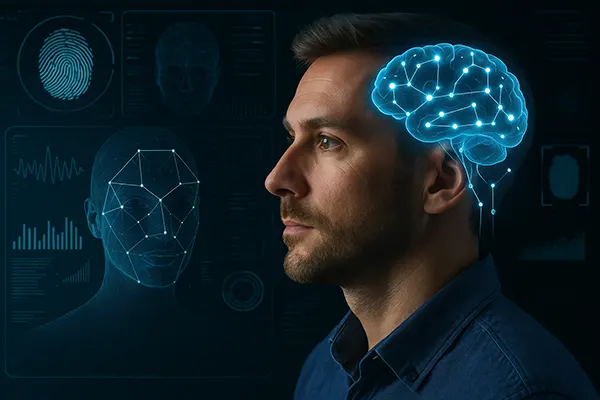Biometrics of the Future: How Behavioural Patterns and Neural Interfaces Reshape Security and UX

Biometric technologies have evolved far beyond fingerprints and facial scanning. By 2025, organisations increasingly rely on behaviour-driven identification and early neural-interface tools to deliver stronger security and more seamless interactions. These innovations shift the focus from static traits to dynamic human patterns, providing insight into intent, cognitive load and subtle markers of authentic identity.
Behavioural Biometrics as a Core Security Layer
Behavioural biometrics examine how a person interacts with digital systems: typing rhythms, touchscreen pressure, mouse trajectories, gait patterns and navigation habits. These signals cannot be easily imitated and are continuously monitored, making them valuable for preventing account takeovers and automated attacks. Modern machine-learning models analyse these micro-patterns in real time, detecting even slight deviations from a user’s established profile.
Financial institutions, mobile banking services and enterprise networks increasingly adopt behavioural verification to supplement or replace passwords. Unlike one-time checks, this method evaluates identity throughout the entire session, reducing fraud linked to stolen credentials. As risk scoring becomes more accurate, legitimate users experience fewer interruptions, while suspicious activity triggers adaptive authentication mechanisms.
Privacy considerations remain essential. Leading providers now use on-device analysis, differential privacy and encrypted feature extraction to minimise exposure of raw behavioural data. These safeguards help maintain trust while enabling advanced threat detection across large user groups.
Integration with Zero-Trust Architectures
Zero-trust frameworks, now standard across many industries, benefit greatly from behavioural analytics. Instead of granting ongoing access after a single login, systems continuously reassess identity signals, context, device hygiene and access intent. Behavioural indicators form an additional layer, contributing to risk-based decisions that restrict or allow user actions.
Organisations deploying zero-trust models in 2025 use behavioural telemetry to differentiate legitimate workers from compromised endpoints or covert automation tools. Abnormal typing cadence, navigation loops or cursor hesitations are often early signs of phishing-based intrusions or remote-access manipulation.
The combination of behavioural biometrics and zero-trust practices results in adaptive security workflows. Authorisation becomes fluid, not fixed, supporting large remote teams and hybrid workplaces where identity threats are more dynamic.
Neural Interfaces and Their Impact on Digital Interaction
Neural-interface research has advanced significantly, driven by medical applications and human-computer interaction studies. Non-invasive EEG headsets, neural-sensing earbuds and near-infrared spectrometry devices now deliver more precise readings of cognitive signals. These emerging tools detect attention levels, intent patterns and emotional states, offering new possibilities for UX design and accessibility.
In the security domain, neural signatures can complement traditional authentication. Early prototypes match users through stable neural-response patterns when exposed to specific visual or auditory prompts. These signals are difficult to forge, providing an additional protective layer for high-security environments.
Meanwhile, UX teams experiment with adaptive interfaces that respond to mental workload. Systems can simplify layouts, adjust notification timing or modify task flows based on detected cognitive strain, making everyday interactions more efficient and less distracting.
Ethical and Regulatory Considerations
Neural data is highly sensitive, raising concerns about storage, consent and permissible use. By 2025, several regions have begun drafting specialised regulations governing neuro-information, treating it similarly to medical data. Transparency, minimal data collection and user-controlled permissions are becoming mandatory components of responsible product development.
Companies working with neural interfaces adopt strict safeguards, including encrypted on-device processing and limited retention policies. Ethical frameworks require clear communication about what signals are captured and how they contribute to UX or security enhancements.
Industry groups continue developing standards to prevent misuse. These guidelines promote voluntary participation, optional data sharing and rigorous separation between biometric analysis and behavioural profiling unrelated to core user needs.

The Convergence of Behavioural and Neural Technologies
As behavioural biometrics and neural interfaces mature, they begin to complement each other. Behavioural signals reflect external patterns, while neural indicators provide internal context. Combined, they create multi-layered profiles that distinguish legitimate users from threats with far greater accuracy than traditional authentication factors.
Advanced identity systems now merge typing tempo, cursor behaviour, environmental context and neural-response cues to evaluate risk. This multi-modal approach increases resilience against spoofing, deepfake tactics and coordinated fraud, all of which have become more sophisticated by 2025.
For UX designers, convergence introduces the possibility of interfaces that respond both to actions and cognitive states. Systems can adapt to user intent and concentration levels, offering smoother interactions, reduced friction and more personalised digital experiences.
Future Prospects for Secure and Human-Centred Design
The next stage of development will likely focus on lightweight neural sensors embedded in everyday devices: headsets, eyewear, audio accessories and AR tools. These sensors will work alongside behavioural analysis to create frictionless verification processes. Authentication may eventually occur in the background, with disruptive prompts appearing only when risk models detect anomalies.
Such systems will require transparent governance to ensure they remain beneficial rather than intrusive. Clear boundaries, robust privacy controls and user-driven permissions will determine public acceptance. Organisations that respect these principles will be better positioned to integrate innovative biometric tools responsibly.
Overall, the union of behavioural analytics and neural-interface technology marks a significant shift towards identity systems that are both secure and centred on real human behaviour. As research expands, these technologies will define the next generation of trustworthy, intuitive digital environments.
